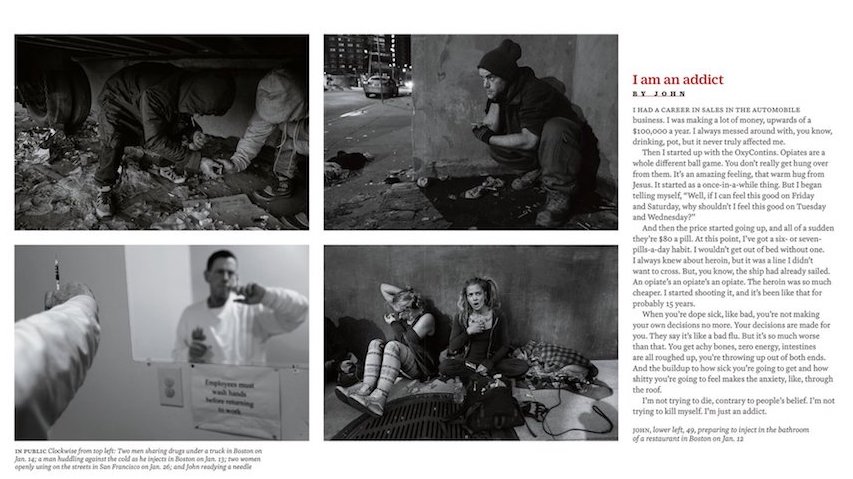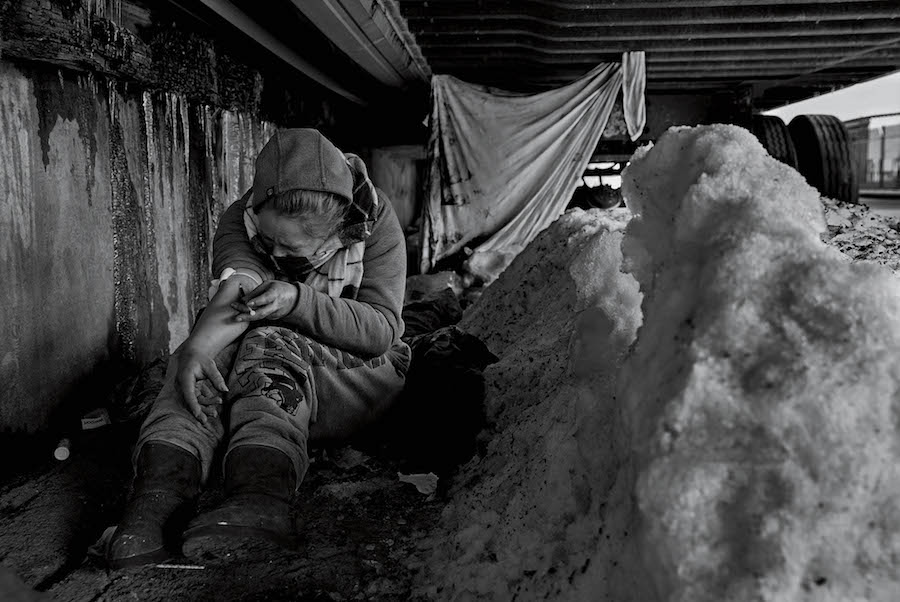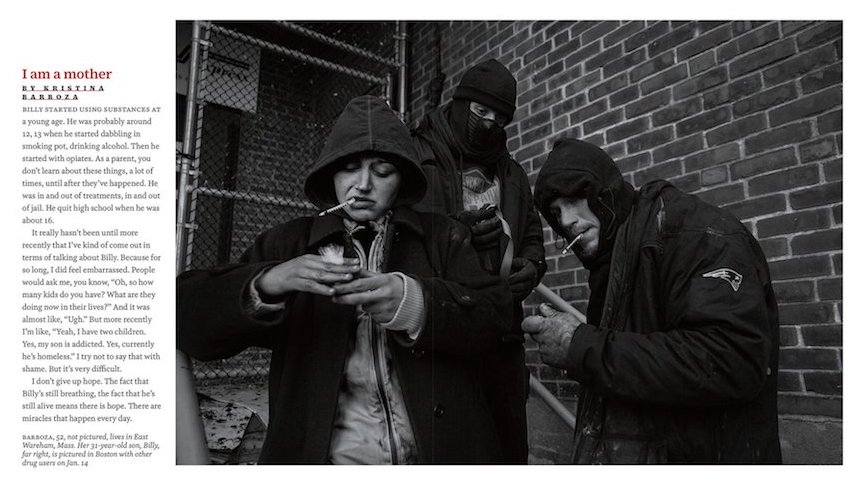Time's deputy editor of photography, Paul Moakley, says he remembers exactly when his two-year journey to document America's opioid epidemic began. "A photo came to my desk," he told Poynter. "It was a picture of a little boy in a car in Ohio."
He is talking about the photo from East Liverpool, Ohio of a young boy sitting in the back seat of a van with his grandmother and her boyfriend slumped over, overdosed in the front seats. "There are a lot of ethics questions about the photo. I thought they were dead, and then after thinking about it, I just wanted to know everything about the image. The magazine sent me out there to do a story about the police officers who took the photo."
This week, Time published a magazine that is, cover-to-cover, the work of Moakley and photojournalist James Nachtwey. There is no advertising in this issue. Just page after heartbreaking page of photographs and text that calculate the human toll of the American opioid epidemic that kills 64,000 people a year. And there is nothing that leads us to believe the problem has peaked.
After he explored the details of the child in the van, Moakley began tracking down two people captured on video in Memphis. A social media video of two people on a city street strung out on heroin attracted 5 million views and thousands of hateful comments about the couple. In the Time "Opioid Diaries" edition, Moakley tracked down the couple to hear their painful life story that includes more than 40 years of addiction and crime to support it.
"I think that oftentimes, we see these stories where people are photographed from the back or the shadows. We were looking for something that went deeper and was closer to people. It was hard. We were seeing people in the critical moments in their lives, but spent a lot of time going back to them."
Nachtwey is best known for his work in conflict zones including Bosnia, Kosovo and Rwanda. Some consider him to be among the great war photographers in recent decades. TED talks featured his work and his quiet plea to allow his photographs to bear witness to the conflicts he has covered in 30 countries. At the end of the Time Opioid Diaries project, Nachtwey writes:
The only way to make real sense of it, I told my editors, was to see what happens to individual human beings, one by one.
Photography can cut through abstractions and rhetoric to help us understand complex issues on a human level. Never is photography more essential than in moments of crisis. To witness people suffering is difficult. To make a photograph of that suffering is even harder. The challenge is to remain open to very powerful emotions and, rather than shutting down, channel them into the images. It is crucial to see with a sense of compassion and to comprehend that just because people are suffering does not mean they lack dignity.
Moakley said he researched the story for nearly two years; Nachtwey began photographing it 10 months ago. Moakley said Time director of photography Kira Pollack "Pushed me to focus on this." A year ago, he started working just on this project. "It is just unheard of," he said. "James captured a couple thousand pictures. He sends us very tight edits of things so we were surprised when he would send these longer edits a couple of hundred pictures. It was amazing to see his precision." Nachtwey and Pollack teamed up for the difficult photo editing process, deciding how graphic is too graphic and how to be intimate without exploiting people's addiction.

Moakley and Diane Tsai captured video for the project. Moakley struggled to explain how a journalist can spend so much time with addicts who, right in front of them, are injecting themselves with doses that could be their last. "I try to be really comforting around anyone I work with. That is my style," Moakley said. "You don't want them to do that to themselves. You begin to understand how much it controls them."
Moakley said every person they photographed, every person they profiled in their project, knew who the journalists were and what they were doing. And, he said, "People gave us consent. People kept saying you have to show this. I am in hell and people need to see what I go through. We never met anyone who yelled at us. They wanted to open up about what they were going through."
The reader comes to recognize that the drug user affects many others. One story followed a woman fighting addiction even while she is pregnant knowing she has already harmed her baby.
One photo caption of a grandmother, next to her 24-year-old granddaughter's casket, quotes the grandmother: "After Michaela died, I saw it clear as day. They're not only destroying themselves, they're destroying us." Her mother said in a video version of the story, that she was "prepared" for news one day that her daughter had died of an overdose, she just wasn't prepared for the news her daughter had been brutally murdered.
"The Opioid Diaries" tells how in case after case, what became drug abuse started as legitimate drug use. They tell the story of a high school football player who hurt his back and got opioids to ease the pain. Now he is addicted to heroin. Time travels with police officers, community health workers and EMTs who often see the same people, overdosed day after day.

Nachtwey's black and white still images force the reader to linger on the page. One of the most haunting images is not the most graphic. It is a photo of an aging woman named Jen. In the photo, she sits beneath the carriage of a truck in the freezing Boston cold, trying to inject herself with heroin. An empty needle lies by her feet, a syringe in her hand, she tries over and over with blood running down her arm to hit a vein with the needle. "It was brutal to watch that moment — it lasted for over an hour trying to inject," Moakley recalled. Her friends tried to help her, he said. "She let never anybody near her."
Why, in this age of artificial intelligence, drone videos and 360 panoramas, would Time turn to black and white still images to tell a story of such prominence and effort? "Still photography matters," Moakley said. "It will always matter, the same way that paintings, films, and novels will matter. If somebody has the talent to communicate using their genius talents, it will matter." Moakley said working with Nachtwey, he learned that the photographer "Is not just documenting things — he is trying to communicate an emotion that is happening in front of him."

The Time team will travel to Washington, D.C., next week to meet with senators and others to share their findings. "Our editors wanted to make a statement with this story," he said. Readers who know this epidemic well will still learn from this work. As deep as this epidemic has grown, the story does not linger just on the problem but looks for solutions.
Time documents how needle exchanges and "safe injection sites" work. Online viewers listen to inmates speak of their determination to stay clean once they get out of lockup even though the odds are against them.
"We hope readers will come away thinking, 'What if we gave them a safe place to do these drugs — a safe injection space.' What kind of opportunity would it open up if we were just a little kinder?" Nachtwey, who as a photojournalist has witnessed the worst that the world can offer humanity, offered readers glimmers of hope that this work, raw and disturbing as it is, may stir the country to action:
Over the past 35 years, my work as a photojournalist has taken me to other countries to document wars, uprisings, natural disasters and global health crises. In revisiting my own country I discovered a national nightmare. But the people living through it aren’t deviants. They are ordinary citizens, our neighbors, our family members. I don’t think I met one user whom I would consider to be a bad person. No one wants to be an addict.
I also saw signs of hope, particularly from the people who are dealing with the crisis at the street level. Some of them are former users who have lifted themselves up and are using their experience to help others. They are refusing to allow our country to be defined by this problem. Instead, they are helping us define ourselves by finding solutions. We must join them.
Watch all of the videos at this link.






